| Line 169: | Line 169: | ||
* The movie was originally released in North America on home video in 1987 by Family Home Entertainment, minus Spike's swear. Not long after, it was releasd in the UK by Video Gems. This version featured the opening text crawl and closing narration inherent to the UK version of the film. In Australia, the film was releaed on video by RCA/Columbia Pictures/Hoyts. In Japan, Hillcrane released a Laserdisc version alongside a VHS copy. |
* The movie was originally released in North America on home video in 1987 by Family Home Entertainment, minus Spike's swear. Not long after, it was releasd in the UK by Video Gems. This version featured the opening text crawl and closing narration inherent to the UK version of the film. In Australia, the film was releaed on video by RCA/Columbia Pictures/Hoyts. In Japan, Hillcrane released a Laserdisc version alongside a VHS copy. |
||
| − | * The Movie was released in Brazil on home video on the late 80's but on a very small scale, |
+ | * The Movie was released in Brazil theaters simultaneously to the launch of the series on television. It was later released on home video on the late 80's but on a very small scale, which made it very hard to find on video stores. The movie was exhibited on television just once and received a new dub for this. [[Brazilian dubs for the Movie|Which dubbing is the best]] is a regular debate topic among Brazilian fans. |
*The movie was realeased spottily in the 90s, beginning with a budget VHS by Avid Home Entertainment in 1991. Malofilm released a VHS in Canada in 1995, notable for being the first home entertainment version to include Spike's swear. In 1998, Japanese company Pioneer produced another pair of Laserdisc and VHS releases. In 1999, things kicked off when American company [[Kid Rhino]] secured the Transformers license and released the film on VHS once again. |
*The movie was realeased spottily in the 90s, beginning with a budget VHS by Avid Home Entertainment in 1991. Malofilm released a VHS in Canada in 1995, notable for being the first home entertainment version to include Spike's swear. In 1998, Japanese company Pioneer produced another pair of Laserdisc and VHS releases. In 1999, things kicked off when American company [[Kid Rhino]] secured the Transformers license and released the film on VHS once again. |
||
Revision as of 05:06, 5 February 2008
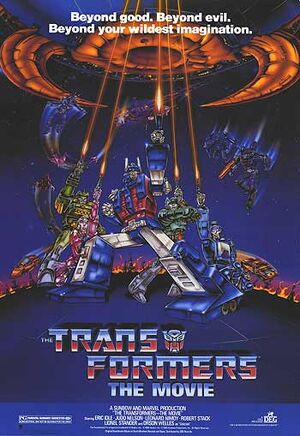
Featuring the deaths of all your favorite Transformers characters.
Template:Episodenav The Transformers: The Movie is an animated feature film based on the original Transformers toyline. It was released in the United States on August 8, 1986.
Often referred to by fans simply as "the movie" or "TFTM", this film opens with characters who had been featured in the first two years of the toyline and associated media (cartoons, comic books, etc.), but quickly introduces new characters and kills many of the old ones to make room. In particular, Optimus Prime, Megatron, and Starscream are all destroyed during the course of the film.
The movie was a step up in almost every area from the television series, with a more sophisticated plot, more serious treatment of war and violence, a hugely ambitious scope and a greatly increased animation budget with well-known celebrities providing voice work. For these reasons the film remains very popular with children of the 1980s.
Primary characters and cast
- Optimus Prime...Peter Cullen
- Ultra Magnus...Robert Stack
- Perceptor...Paul Eiding
- Hot Rod...Judd Nelson
- Kup...Lionel Stander
- Blurr...John Moschitta Jr.
- Springer...Neil Ross
- Arcee...Susan Blu
- Wreck-Gar...Eric Idle
- Daniel Witwicky...David Mendenhall
- Megatron...Frank Welker
- Starscream...Chris Latta
- Galvatron...Leonard Nimoy
- Unicron...Orson Welles
Brief synopsis
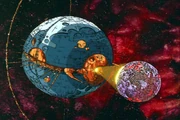
That's no moon. It's a space station.
A planet-sized Transformer called Unicron who eats other planets is approaching Cybertron. As part of their continuing wars, the Autobots and Decepticons have a fierce battle on Earth which sees both Optimus Prime and Megatron mortally wounded. Prime passes the Matrix of Leadership to Ultra Magnus and dies, and Megatron is transformed by Unicron into Galvatron. Starscream (briefly) assumes leadership of the Decepticons, but is killed when Galvatron arrives at Cybertron. Galvatron then chases the surviving Autobots on Earth across space, splitting them up and taking the Matrix. The Autobots find their way back to each other, and follow Galvatron to Cybertron just as Unicron transforms into robot mode and begins to eat their world. Travelling inside Unicron, Hot Rod recovers the Matrix, transforms into Rodimus Prime, and uses the Matrix to destroy Unicron.
Full synopsis
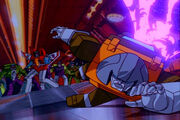
I have a bad feeling about this.
In the first sequence of the film, a mechanical planet called Unicron is shown travelling through the depths of space, then approaching and destroying another metal planet which has robotic inhabitants, much like Cybertron. During the attack, robots, vehicles, buildings, and even large chunks of rock float off the surface of the planet and spiral into the large "mouth" on Unicron.
The scene then transitions to Cybertron, and the narrator explains that it is the year 2005, and that the Decepticons are now in control of the planet. The Autobots are preparing to launch an assault to retake the planet from hidden bases on two of Cybertron's moons. The Autobots launch a shuttle to pick up a final shipment of energon from Earth before they strike.
Plans for the attack are overheard by Laserbeak, who reports back to Megatron. The Decepticons attack the Autobot shuttle en route to Earth, wiping out its crew (including Ironhide, Prowl, Ratchet and the guy in the picture up there). Using the Autobots' own shuttle, the Decepticons are able to get very close to the Autobots' base on Earth, Autobot City, before they are detected, and begin a devastating surprise attack on the unprepared city.
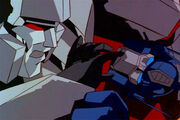
If you strike me down, I shall become more powerful than you can possibly imagine.
During the battle at Autobot City, both Optimus Prime and Megatron suffer mortal injuries, and a number of other characters are also killed. Eventually the Decepticons retreat, but the damage suffered by the Autobots has been severe.
For an extensive synopsis of the battle, see Battle of Autobot City.
Shortly after the battle, Prime lies on his deathbed. He passes the reins of leadership to Ultra Magnus and gives him the Matrix of Leadership. (Though Hot Rod actually touches the Matrix before Magnus does.) Prime relates a prophecy: "One day, an Autobot shall rise from our ranks, and use the power of the Matrix to light our darkest hour." He then gives the oath, "'Til all are one", and dies. This sequence of events is observed remotely by Unicron, who appears unusually concerned by the survival of the Matrix.
The Decepticons are making their escape aboard Astrotrain, but are too heavy for him to get them all home under his own power. After putting the matter to a fair vote, the Decepticons decide to throw their injured members off the ship to better the chance of survival for the rest. One of the most severely injured Decepticons is Megatron. Starscream tosses him out and claims leadership of the Decepticon army.
Megatron and the other adrift Decepticons then encounter Unicron in interstellar space. Unicron offers to rebuild Megatron and his minions in exchange for their service. Megatron agrees, and is reformatted into Galvatron. The other Decepticons are turned into Cyclonus, Scourge, and the Sweeps. Unicron provides them with a ship, and sends them to kill Ultra Magnus and destroy the Matrix, stating that the Matrix is the only thing which can stand in his way.
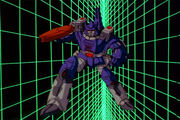
Don't be too proud of this technological terror you've constructed.
Galvatron first stops at Cybertron to take his revenge by killing Starscream and reclaiming leadership of the Decepticons. Almost immediately afterwards, Unicron arrives in Cybertron's vicinity and devours at least two moons—both of the Autobots' moon bases are destroyed. Under coercion by Unicron, Galvatron finally heads to Earth to kill Ultra Magnus, but Magnus and the other surviving Autobots flee in a pair of shuttles. Eventually Galvatron manages to cause one shuttle to crash on yet another metal planet (Quintessa), and detonates the other with a volley of missiles. However, the Autobots in the second shuttle escape unnoticed by separating the front portion of their shuttle just before impact.
The Autobots in the crashed shuttle, Hot Rod, Kup, and the Dinobots, find themselves separated and in a hostile environment. Hot Rod and Kup are captured by a squad of Allicons and taken before a Quintesson judge and his court. While being held there, they learn the name and nature of Unicron from Kranix, a survivor of the planet destroyed in the opening of the film, which he calls Lithone. Meanwhile, the Dinobots encounter and befriend a young, wild Autobot named Wheelie who has been living alone on Quintessa. Together, they crash the trial just as Hot Rod and Kup are fighting losing odds against the Quintessons' Sharkticons. The tide is turned, and the Autobots commandeer a Quintesson ship.
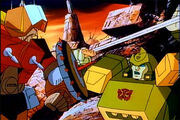
What an incredible smell you've discovered!
The other group of Autobots has landed on the planet Junkion to make repairs, but are attacked yet again by Galvatron, who was tipped off to their survival by Unicron. During the battle, Ultra Magnus tries to open the Matrix to use its power, but is unable to do so, and instead is killed. Galvatron absconds the Matrix, taking it away to Unicron. The remaining Autobots—Perceptor, Springer, Arcee, and Spike's son Daniel—are then ambushed by Junkions, the eponymous natives of Junkion, who are also giant transforming robots. This battle is cut short, however, by the arrival of Hot Rod's group in their Quintesson ship. After exchanging the universal greeting they all make friends, and the Junkions restore Ultra Magnus to life. Together, the whole group travels to Cybertron to try to recover the Matrix.
Galvatron attempts to open the Matrix to use its power against Unicron, but is also unable to get it open. Unicron, not pleased with this attempted treachery, shocks Galvatron by transforming from a planet into a planet-sized robot. Unicron plucks Galvatron off his chest and swallows him, Matrix and all, and then begins attacking Cybertron itself. Shockwave scrambles the Decepticon forces to defend the planet, but they are ineffective against so large an enemy. Shortly the Autobots arrive from Junkion, and fly the Quintesson ship straight through Unicron's eye. This impact destroys the ship, and the Autobots fall out inside Unicron. Hot Rod, separated from the others, eventually runs into Galvatron. During their fight, Hot Rod gets his hands on the Matrix and hears Optimus's voice speak the words, "Arise, Rodimus Prime." Hot Rod grows in stature, adopts a much sterner demeanor, and quickly dispatches Galvatron by tossing him through Unicron's hull out into space. He then opens the Matrix, which fills Unicron with light and begins destroying him.
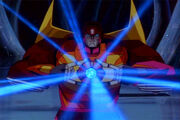
Use the Force, Luke.
In the meantime, the other Autobots inside Unicron have located some of their comrades from the moon bases who had been presumed dead, including Bumblebee and Daniel's father, Spike. The Autobots, including Rodimus, escape through Unicron's remaining eye just as he begins to fall apart and explode. The scene then immediately shifts to the surface of Cybertron, where—for unclear reasons—the Autobots seem to be in charge again. Rodimus predicts an era of peace and prosperity, and the film closes with a shot of Unicron's severed head still floating in orbit around Cybertron.
Significance in Transfandom
The Transformers: The Movie remains one of the most important elements of the entire Transformers brand, both within the fiction and from the perspective of the brand's popularity and "mindshare".
Fictionally, it established several story concepts that have been used repeatedly in the years since 1986, some of which—such as Unicron and the Matrix—are now central to the entire Transformers mythos. The movie is also the centerpiece of the most well-known Transformers continuity: the G1 animated universe. The G1 cartoon is split into "pre-movie" and "post-movie" sections which feature different characters and settings, and even somewhat different visual styles. (Most pre-movie episodes were animated by the studio Toei, while most post-movie episodes were animated by AKOM.)
On a practical note, it was widely available on videotape, and remained so long after the Generation 1 cartoon had gone off the air. Only a handful of series episodes were available on video, making The Transformers: The Movie the logical choice for someone looking to pick up a Transformers cartoon; this made it far more well-known among fans than any particular cartoon episode.
To an entire generation of young fans, the movie was the most visually spectacular and narratively epic Transformers experience of their entire youth. Events such as the death of Optimus Prime are widely reported to have reduced many kids to tears. It is hardly a surprise that these emotional experiences embedded themselves deeply in many fans' memories.
Criticisms
All this is not all to say that the movie is a "masterpiece", exactly. The film met with extremely harsh critical reviews on its release, and some of those criticisms still ring true today.
The film displays an arguably cynical attitude towards itself as a vehicle for advertising toys, especially in the way beloved characters are killed—sometimes gratuitously—for sake of justifying the story's focus on a new group of toys. (Note that the poster at the top of this article features only new characters.)
Further, the two primary plot devices—Unicron and the Matrix—have no prior establishment in the fiction. Unicron is given no backstory or justification; he simply exists, and is very dangerous, and is afraid of the Matrix, all for no adequately explained reason. The introduction of the Matrix itself is a heavy retcon. The story asks the audience to accept that this cosmically powerful artifact has been in Prime's possession all along (even though an X-ray of Optimus Prime's innards in the second season episode "A Prime Problem" show absolutely no signs of said Matrix), but has somehow never been relevant before.
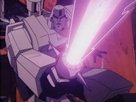
Your powers are weak, old man!
The movie bears many similarities to Star Wars: There are several character-parallels (Springer is a Han Solo-type and Arcee even has Princess Leia's hairdo!), the primary threat is similar (it's the Death Star... but it transforms!), and both feature a climactic battle where the young hero hears the voice of his wise mentor one last time before saving the day.
To be a bit more fair to The Transformers: The Movie, however, most of these similarities are either superficial (Arcee's Leia-hair; Megatron's "lightsaber" he briefly uses in his duel against Optimus Prime) or can be seen as elements common to thousands of years worth of epic storytelling through human history, not just common to Star Wars. As a simple example, the phenomenon of two charismatic leaders dealing each other mortal injuries in battle hearkens back to some versions of the "King Arthur" myth; in their final battle, Arthur and his arch-enemy Sir Mordred deal one another lethal injuries and both apparently expire -- though Arthur according to the legend will return when England's need is greatest.
Though most likely coincidental, the movie also bears many similarities to the Marvel Comics Fantastic Four story "The Galactus Trilogy":
- The presence of an enormous world-devouring cosmic entity that threatens to destroy the heroes' home planet (Galactus/Unicron).
- The presence of a single item that is the only thing that can stop said cosmic entity (Ultimate Nullifier/Matrix of Leadership).
- The presence of a herald of said cosmic entity, who ultimately betrays the entity (Silver Surfer/Galvatron).
Trivia and controversies
This film was one of the last professional performances by Orson Welles, if not the very last. According to production materials shown at BotCon 2000 by Tim Finn, the voice recording sessions for The Transformers: The Movie were done on September 10 and 11 of 1985. Welles died on October 10 of that same year. It has often been speculated that Unicron's last line ("Destiny... you cannot destroy my destiny...!") was recorded by another actor—possibly Nimoy—because it sounds different than the other lines. This speculation has been quashed by statements by Transformers voice director Wally Burr.[1]
The Dinobot Snarl is mysteriously absent from almost the entire movie (maybe he was scared of getting killed off), even though the Dinobots as a group are featured prominently. It is unclear why this is the case, but one possible explanation is that copies of the script which have come into fans' hands repeatedly list the Dinobots but never make mention of Snarl by name. In fact, at one point the script refers to "the four Dinobots". Despite this, Snarl does appear in three very brief shots, although he has no lines and no action.
Also curiously absent are the 1985 Autobot cars and Mini-Vehicles, such as Inferno, Smokescreen, Cosmos, Warpath, etc. It would seem that these characters were available at the time of the movie:
- Perceptor and Blaster both debuted at the same time in the cartoon as the 1985 cars, and both play prominent roles in the movie.
- Grapple is seen very briefly during the battle for Autobot City.
- The 1985 Decepticons (Astrotrain, Dirge, etc.) appear in the film.
- Tracks, Red Alert and Smokescreen all appeared in storyboards but not the finished film.
With the exception of Starscream, Unicron, and possibly Shockwave, only the Autobots suffered causalities in the movie. All of the other "dead" Decepticons from the Autobot City battle were rebuilt into Galvatron's new troops, and although more Decepticons were shown taking heavy damage and suffering huge casualties while fighting Unicron, their identities and their condition are uncertain. Additionally, both Starscream and Unicron survived in the post-movie series in some form or another. Shockwave's death in the finished film is highly uncertain, although in the script it is fairly strongly implied. He does make some appearances in crowd shots in later cartoon episodes, but these may be examples of the fairly common animation errors in those episodes.
Originally, Ultra Magnus's "death sequence" on Junkion called for him to be lassoed and drawn and quartered by the Sweeps' energy beams, but this was deemed too graphic for audiences, hence the less disturbing "shot to death" sequence seen instead. There is evidence that the original sequence had been fully animated when the decision was made, however; the Sweeps still kept their solid energy lassos when they fire upon Mags, and Mags is seen visibly straining against what appears to be said lassos (edited out and replaced with laser fire) before exploding.
A number of other sequences were storyboarded but dropped, presumably without ever being animated. Most notable among these was a scene that would have shown the Autobots finally bringing down Devastator with a barrage of missiles (and the Constructicons subsequently shooting Red Alert in the back), and the Decepticons dogpiling Optimus Prime, explaining why he seems to be standing up just before his fight with Megatron.
In Hungary, the movie has two dubs. One of them is ancient and unprofessional, the other recent and more professional. The second and more disliked one has a reputation among the fans for including more profanities than the original version of the film. Although Spike's "Oh, shit!" line was cut, Ironhide, Galvatron and the Dinobots say terms akin to "assholes", "jerk", "stupid", "rotten", and "ass-wipes" (this one even twice, when referring to the Decepticons). Quite interesting, seeing as the dubs produced in that era have been known for freeing the movies of their swear words. These dubs are also infamous for using untranslated or incorrectly translated names, and random voice actors for random characters with random voice-pacing. These names include Unicornis (Unicron), Mega-robot (Devastator), Constructors (Constructicons), Deceptors (Decepticons), and Jettison (Astrotrain, probably derived and mis-interpreted from the line "Jettison some weight."). The DVD case has G.I. Joe pictures printed on it, as well as on the DVD itself. Spiffy. It's also worth noting that Bumblebee in the 2007 movie has the same voice he had in the second dub of The Transformers: The Movie. Probably a coincidence, since that guy supplied half of the voices for the cast back then.
Rumors have occasionally circulated in the fandom of additional animated footage that was dropped from the film, such as ultra-violent battle scenes. No evidence has ever surfaced to back these claims; the only known edits are those listed below.
See also Urban legends about The Transformers: The Movie.
Animation Errors
There are a few notable animation errors in the movie:
- When Ultra Magnus accepts the Matrix, he's seen inserting it into his chest twice, or at best readjusting its "fit". (Some fans have joked that Mags was forcing the Matrix inside him, as another sign that it had chosen Hot Rod as the new leader and rejected him.)
- Swoop's lower leg appears for a brief second during the Autobot City battle, long before the rest of him gets there.
- Not so much an error, but if you watch Sludge when he's haymaker'ed by Devastator, his eyes pop out of their sockets in Looney Tunes fashion.
- Sunstreaker appears with Huffer, Bluestreak and Kup when they observe Hot Rod firing on Ironhide's shuttle. Sunstreaker later appears as Optimus Prime's co-pilot when they arrive with the Dinobots, and is seen disembarking the shuttle along with Optimus Prime and Hound.
- Hot Rod has at least two totally different transformation schemes during the course of the film.
- When Hot Rod tells the Junkions the universal greeting, the Autobot insignia on his chest is coloured black.
Continuity Errors
- Despite running out of energon goodies on Quintessa, Hot Rod has at least one to offer to the Junkions. Maybe he got some on the ship.
- So Ultra Magnus just happens to have a ready-made Matrix chamber installed in his chest cavity? Is this standard issue for all Autobots?
Formatting and Edits
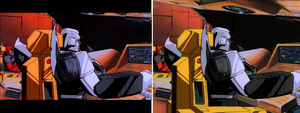
The widescreen picture (left) cuts the top and bottom off the fullscreen picture (right).
Although it was billed in some advertisements before its theatrical release as being "widescreen", the movie was in fact animated in a 4:3 (fullscreen) aspect ratio. For its theatrical screenings, the film was matted down in the projector by the projectionist to a 16:9 aspect ratio (widescreen), chopping the top and bottom off the picture, but all video transfers of the movie were done without mattes, meaning that there was actually more picture visible in the fullscreen video and DVD releases than there would have been in theaters. Across 2006 and 2007, new editions of the DVD of the film were released by Sony BMG and Metrodome which applied the mattes in order to replicate the original theatrical presentation of the film for the first time in home entertainment. Some fans, however, didn't realize that the film wasn't actually animated in widescreen, and, hearing that the DVD was to be in widescreen, expected to see the fullscreen image with additional footage at the sides, causing them to complain that the top and bottom were cut off, thereby totally missing the point.
Several English-language versions of the film exist, with the following differences in content from the American theatrical run:
- In some versions (notably the European version) the opening credits are replaced with a scrolling text ("Star Wars style") which provides backstory.
- In some versions (notably the European version) the film ends with a narrator reassuring the audience that Optimus Prime will return.
- Instances of swearing in the film (there are two) were edited out; sometimes one, sometimes both. Those instances are: Spike yelling, "Oh shit, what are we gonna do now?" after the self-destructing Moon Base 2 fails to scratch Unicron, and Ultra Magnus growling, "Open, damn it, open!" while trying to open the Matrix to fend off Galvatron and the Sweeps on Junkion. The United Kingdom cinema version had the swearing included but, when it was released on VHS in the United Kingdom, Spike's line was cut. However it has been restored on all United Kingdo DVD releases.
- Instead of DEG, the Rank Film "gong man" appears before the film, as Rank were the United Kingdom distributors.
Commercial Releases
- The movie was originally released in North America on home video in 1987 by Family Home Entertainment, minus Spike's swear. Not long after, it was releasd in the UK by Video Gems. This version featured the opening text crawl and closing narration inherent to the UK version of the film. In Australia, the film was releaed on video by RCA/Columbia Pictures/Hoyts. In Japan, Hillcrane released a Laserdisc version alongside a VHS copy.
- The Movie was released in Brazil theaters simultaneously to the launch of the series on television. It was later released on home video on the late 80's but on a very small scale, which made it very hard to find on video stores. The movie was exhibited on television just once and received a new dub for this. Which dubbing is the best is a regular debate topic among Brazilian fans.
- The movie was realeased spottily in the 90s, beginning with a budget VHS by Avid Home Entertainment in 1991. Malofilm released a VHS in Canada in 1995, notable for being the first home entertainment version to include Spike's swear. In 1998, Japanese company Pioneer produced another pair of Laserdisc and VHS releases. In 1999, things kicked off when American company Kid Rhino secured the Transformers license and released the film on VHS once again.
- The 21st century's flirtation with The Transformers: The Movie started with a UK budget VHS release of that country's version by Maverick Entertainment. A Japanese company called CatCo followed this up with a VideoCD, and Malofilm—now Seville—were the first to release a DVD version of the film, though it was just a dump of their VHS version.
- In November 2000, The Transformers: The Movie got its first, full professional DVD release from Kid Rhino. This edition, labelled a "Special Collector's Edition", is the first to feature remastered video and audio, and several special features, including storyboards and an interview with Vince DiCola. Rhino concurrently released this version on VHS, sans extras.
- In 2001 in the UK, Maverick Entertainment released their own much-delayed DVD version of the film. It was the UK version of the film, but included Spike's swear. However, the release was burdened by badly interlaced video, though notably included the StarTV dub version of the Headmasters episode "Four Warriors Come out of the Sky" as an extra. This version (including the Headmasters episode) was simultaneously released on VHS.
- The movie was released on DVD in Australia in 2003 by Madman Entertainment, using the same video as the Maverick version, but distinguished by some nifty new cover art by Don Figueroa, and special features not seen on other editions, such as The Touch music video and 80s TV spots.
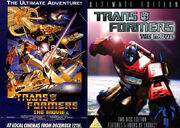
The UK poster art (left) has been the most common DVD and VHS cover in its home country, but the Ultimate Edition featured new art by Andy Wildman (right).
- After acquiring the license to release Transformers DVDs in the UK, Metrodome focused on completing their run of series box sets before turning their attention to the movie properly, releasing only a cheap budget DVD of the UK version through Prism Leisure with no extras, and a UMD of the same version.
- In 2005, Metrodome released "Transformers: The Movie - Reconstructed", a new version of the film designed to expose as much of the animated picture as possible. This, however, only resulted in exposing the rough, unfinished edges of the animation, and an overly pale remaster was compounded by excessive interlacing due to an unnecessary NTSC to PAL transfer. This, coupled with a 5.1 remix from Magno Sound, featuring the same extra sound effects that they added to Rhino's season box sets, made this release both controversial and disappointing to many. This was the first time that the US version of the movie was released in the UK, and the first to feature the US poster art as a cover (although a Silverscreen store exclusive version of the disc included a reversible cover with the UK poster art as well). Extras include trailers, TV spots, the character biographies from the Madman release, and a subtitled version of "Four Warriors Come out of the Sky".
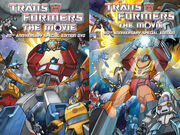
Sony's covers, by Don Figueroa.
- For the movie's 20th anniversary in 2006, new license holder Sony BMG released a two-disc special edition of the film, featuring both a high-quality widescreen remaster and the original fullscreen version, audio commentaries from crew and fans, several new featurettes interviewing those involved in the movie's production, storyboards, tv spots, American and Japanese commercials and more. Most notably, this version included the first Western release of "Scramble City", albeit silent and unsubtitled, featuring only audio commentary. This release featured two covers by Don Figueroa: one is of the '84-'85 cast that appear in the movie, and one is of the movie's new characters, available either as a lenticular hologram that switches between the two, or as a reversible sleeve with the images printed on either side.
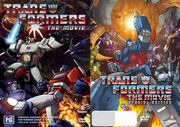
Madman's 2003 DVD cover (left), and their 2007 Special Edition cover (right).
- Delayed a bit to coincide with the hype for the 2007 live-action movie, Metrodome also released a two-disc "Ultimate Edition" with a different widescreen master. Like "Reconstructed", this version used the US edition of the film, but this time, the UK version was also included, in fullscreen, on the second disc. Extras include TV spots, commercials, the Madman biographies, storyboards, commentary, Scramble City (with audio and subtitles), featurettes with Flint Dille and Peter Cullen, and more. The double-disc edition was sold in a steel case featuring new art by Andrew Wildman, with the UK poster art adorning the standard case inside. Various store exclusives were available, including postcards from Play.Com, a reversible cover with the US poster art from HMV, art cards from Virgin Megastore and posters from Woolworths and Toys R Us. It was also available in an extra-less single-disc version.
- The film was released in Full HD 1080p on Blu-ray in the UK in October 2007. The Blu-ray is not region-locked, so it will play anywhere in the world. It features a 2.0 soundtrack, 5.1 Dolby Digital track, and a full bitrate DTS 5.1 track. The master used was the same used by Sony for their US DVD. The picture is quite stunning and the sound very good. Sadly, there are no extras on the DVD. The version of the film on the Blu-ray is the US one, complete with swear word.
- Madman produced their two-disc special edition through some collaboration with Metrodome, and consequently it features much of the same content, with additional extras taking the form of The Touch music video and a bonus episode of Beast Wars. This release again features cover artwork by Don Figueroa, specifically the cover of IDW's Transformers: The Animated Movie adaptation.
Comic Adaptations
- A comic adaptation of the movie was published by Marvel Comics in 1986, concurrently with the movie's theater run. It was based off a non-finalized version of the script, and differs in many details from the final film. Additionally, most of the major character models (and possibly their unedited original character write-ups) appear in Issue #4 of the Transformers Universe series.
- A four-part adaptation was released in 2006/2007 by IDW Publishing, as part of the film's 20th anniversary celebration. It was titled Transformers: The Animated Movie to differentiate it from the Michael Bay live-action film. Unlike its predecessor, it adheres rigidly to the script and plot of the finished movie.
Soundtrack
Released on Scotti Bros. Records, the soundtrack to the movie was made available in both vinyl LP (long-playing) record form and audio cassette. At an undetermined point in the 90's, it was released on CD as well (there are no new markings on the CD booklet or outer case to indicate when the CD was released).
- 1. The Touch - Stan Bush
- 2. Instruments Of Destruction - N.R.G.
- 3. Death Of Optimus Prime - Vince DiCola
- 4. Dare - Stan Bush
- 5. Nothin's Gonna Stand In Our Way - Spectre General
- 6. The Transformers (Theme) - Lion
- 7. Escape - Vince DiCola
- 8. Hunger - Spectre General
- 9. Autobot/Decepticon Battle - Vince DiCola
- 10. Dare To Be Stupid - "Weird Al" Yankovic
In 1997, the newly-formed 3H produced as a BotCon 1997 exclusive a double-CD set called 'Til All Are One. The second disc contains the all of the background score (by Vince DiCola) that was not on the original soundtrack, including several "alternate" pieces for scenes that used songs from the original soundtrack, plus "Legacy", the audition piece that got Vince the job. Other albums released by 3H which include music from the movie are BotCon 97: The Concert, The Protoform Sessions, Artistic Transformations, and Lighting Their Darkest Hour: The Complete Music Score. All of these 3H albums are long since sold out.
On May 29, 2007, Legacy Recordings re-released the soundtrack in a 20th Anniversary Edition containing the above tracks from the original 1986 release plus these additional tracks:
- 11. Unicron Medley - Vince DiCola
- 12. Moon Base 2 - Shuttle Launch - Vince DiCola
- 13. Megatron Must Be Stopped (Parts 1 and 2) - Vince DiCola
- 14. The Transformers Theme (Alternate) - Stan Bush and Vince DiCola
